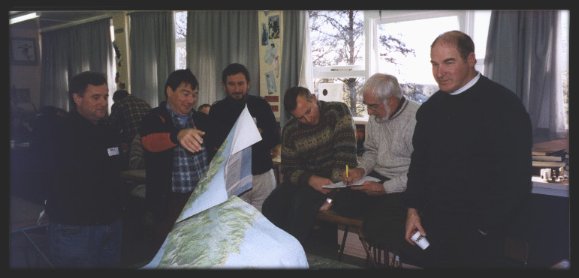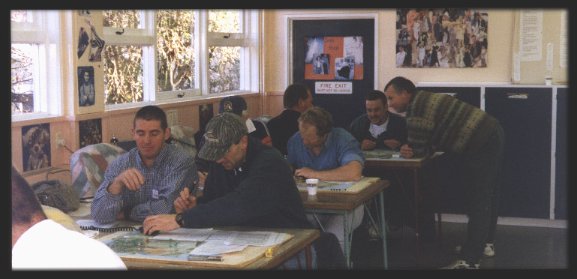1997
Search & Rescue – Paper Exercise.
SAR “PAPEREX” 97.

Search and Rescue personnel out in the field in the wind, rain and snow often wonder what it would be like controlling the operation from the snug comfort of the Field Search headquarters (FSHQ) instead of slogging through creeks, matagouri and steep gorges.
Once a year in Christchurch the teams get their chance to sample the life of a Search Controller in a simulated exercise known as “Paperex”. Working to a prepared scenario, usually based on real life situations, they learn how to deploy search parties, receive and analyze clues reported, obtain weather reports, handle media inquiries and pressure, co-ordinate search patterns among several search teams, cope with emergency situations affecting the searchers, arrange for helicopter assistance if available etc. In short, they have to learn how to keep the whole operation running smoothly and be responsible for its successful conclusion. They also discover that quite often the controllers would rather be out in the bush slogging through the matagouri!

Communications for Paperex was arranged by Geoff Chapman ZL3PX (ZL3EX) and his team from AREC. The setup involved 8 separate FSHQ’s, each communicating with their own field teams and using the same scenario. The exercise was held at the Hillmorton High School, with all the FSHQ’s in one large room and the “search teams” in various other rooms. Arranging communications without causing interference between the teams in the confined area of the exercise has been worked out over the years. Three teams were issued with handheld VHF radios using separate CD frequencies, two teams used POLSAR and Codan HF radios on SAR frequencies and three teams were direct wired between remote control units with ZC1 microphones at each end.
The exercise scenario covers 2 days but the exercise itself is covered in two, three hour, sessions – 0900 to 1200 and 1230 to 1530. The trick of equating scenario time (dawn to dusk) with the 3 hour exercise “day” was achieved by using a neat little computer programme driving slave clocks at the various team and FSHQ positions. Time is advanced by a 1/2 minute every “x” seconds depending on the time ratio required. All the wiring and other setting up was done on the Saturday afternoon and we were back on deck at 0800 Sunday morning to issue radios and make sure that all was in readiness.

The exercise started on time at 0900 and our main involvement then was to sort out any equipment problems (mainly flat batteries) and to observe operating procedures. It was interesting to observe that the teams became increasingly absorbed in their tasks as the day went on, indicating that there was quite a sense of realism being experienced.
At the conclusion of the exercise the teams were debriefed and their performances evaluated with good and weak points highlighted. Radio procedure weaknesses were outlined, such as the importance of using geographic callsigns instead of “Base to Team1”, collecting thoughts before transmitting messages, sending at dictation speed, use of phonetic spelling and when to use it, avoiding use of “over and out”, and so on. Certificates of attendance were issued and these have high value because in real SAR operations when places are being offered on helicopter lifts, it seems that those with certificates will get preference. Everyone went home satisfied that they had benefited from the exercise and now when they are bush-bashing they can appreciate what goes on at Search Headquarters.
Noel ZL3QC